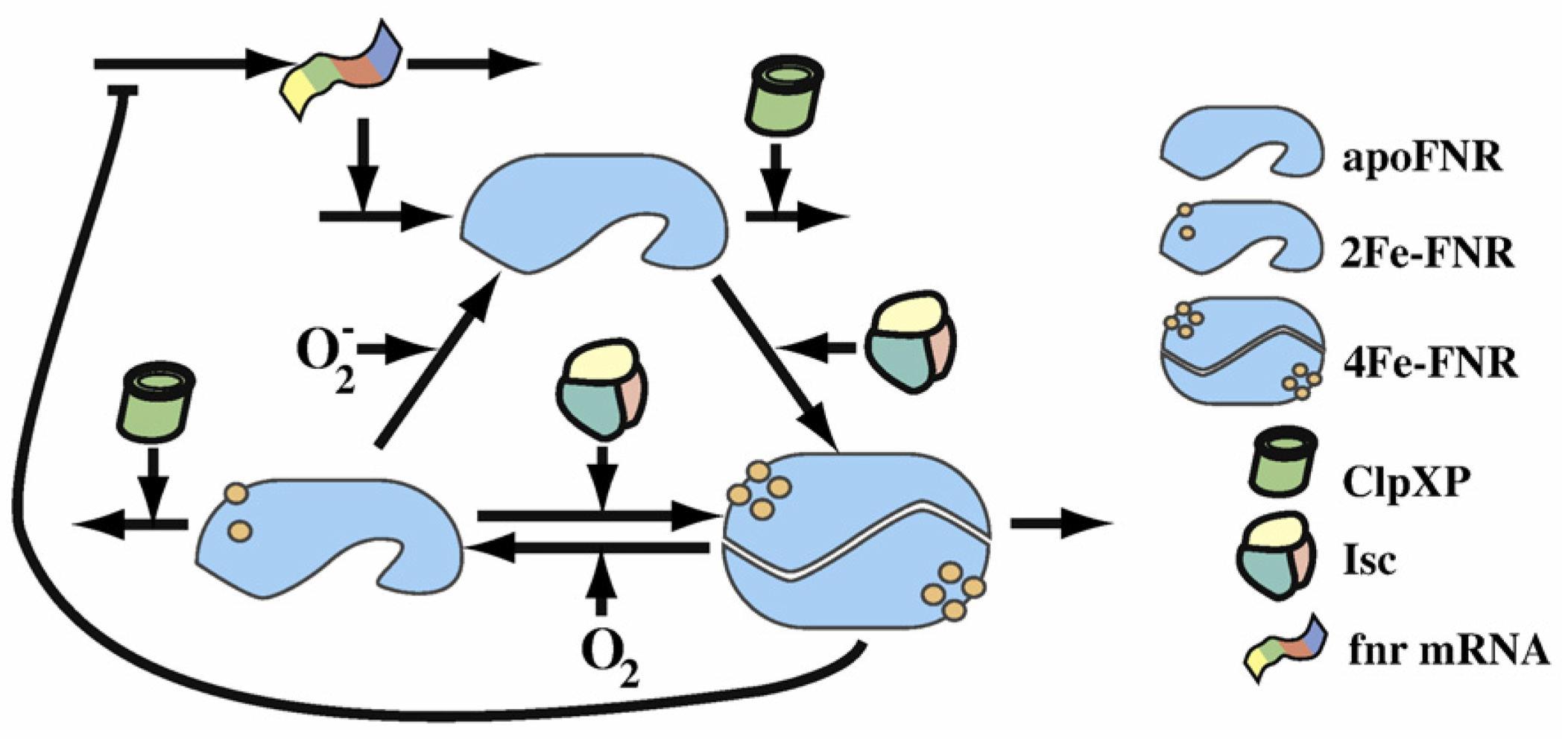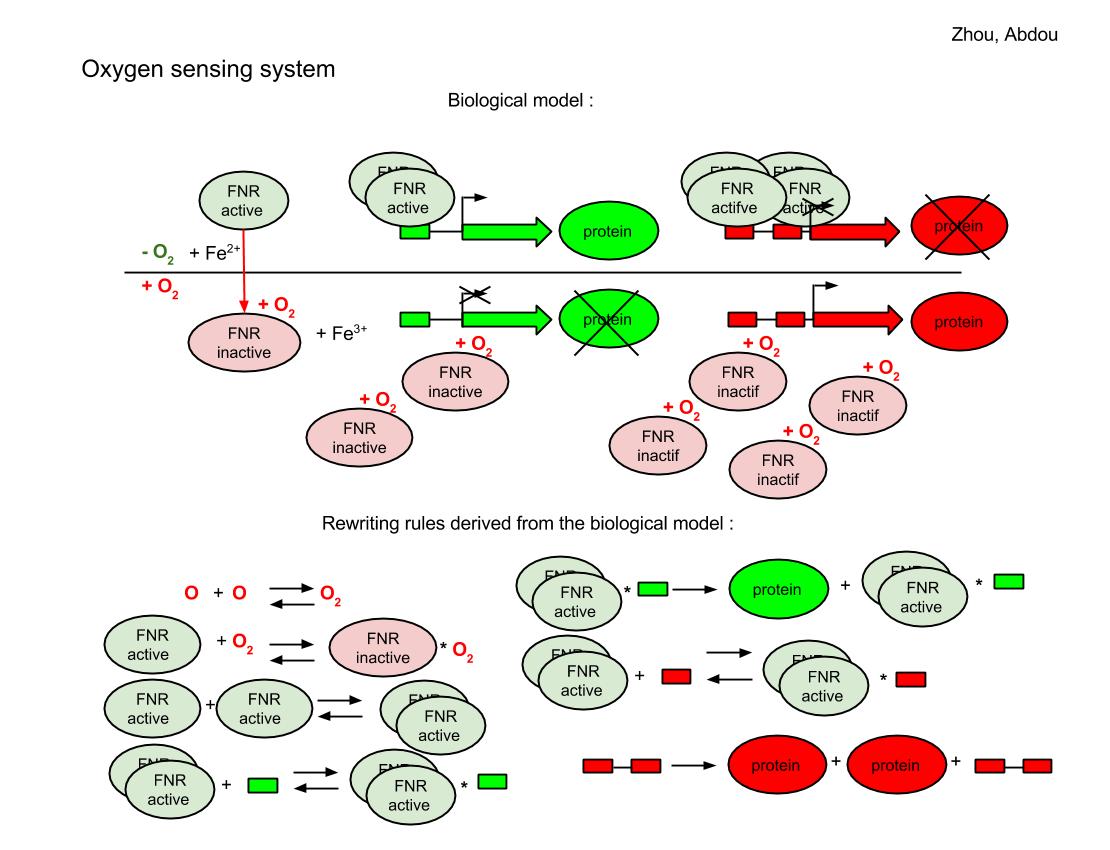Team:Paris Saclay/Modeling/FNR
From 2013.igem.org
Contents |
Modeling our FNR oxygen sensor
Oxygen censor, FNR regulator system modeling
As we use Hsim for the modeling, if you want to dig in our model we suggest you to read this page written by Mr. Patrick Amar the developer of Hsim.
Roughly speaking, we define a sampling volume, size in nanometer and we declare some molecules with their sizes, their moving speed and their number. Once the simulation starts, those molecules move randomly in the space and trigger some possible reaction between them with some probabilities. There is always somehow deviation from the reality, but we are all excited about this particular simulating modeling.
We represent our FNR regulator model to you by 3 steps. We have chosen HSIM, a multi-agents programme developped at our university in order to follow the assembly, movements and dissociation of a large number of molecules in a virtual cell. HSIM replaces the Ordinary Differential Equations and mimics chemical reactions of the real system by rewriting rules. Following our modeling process, we provided the list of molecules, the rewriting rules, and the initial values of each molecule quantity in a configuration file to HSIM. We also have developed a web version of Hsim which allows user change and test the system parameters.
Step 1: translate biological knowledges into functional scheme

This scheme from the Dean A.Tolla and Michael A.Savageauthe's paper shows clearly the FNR transformation cycle. After the fnr mRNA translation, apoFNR is produced and a dimerization of 2 apoFNR catalyzed by ClpXP forme create the 4Fe-FNR. The 4Fe-FNR can be oxidized by oxygen to 2Fe-FNR then to apoFNR. 2Fe-FNR plus ClpXP can generate 4Fe-FNR. And all 3 FNR derivatives sustain a degradation effect. Those proteins will dissimilate in a while.
If we combine the FNR cycle and color reporter system :

The FNR behave differently for aerobic and anaerobic condition. In the case that oxygen is absent, a pair of 4Fe-FNR fix on the reporter DNA sequence and the blue reporter gene is expressed so we will see the blue color for those colonies. But a group of 4 4Fe-FNR come to fix at red reporter’s gen and prevent the expression of red color. If oxygen is sufficient, FNR derivatives keep in inactive form, the red reporter’s gene continue to produce the red color.
Step 2: transcribe functional description into equation system
Summary for equations:
- translation of Pfnr gene into FNR protein (FNR without Fe)
- dimerisation of 4Fe-FNR (action of Ise protein)
- oxydation: in aerobic conditions, oxygen inactivates FNR but cell continues to reactivate it (action of Ise protein)
- activation/inactivation of a gene under a repressor promotor (green) and production or not of the cognate protein
- activation/inactivation of a gene under an activator promotor (red) and production or not of the cognate protein
Details
- Translating fnr to FNR
- fnr mRNA generates steadily apoFNR(inactived).
- fnr -> fnr + apoFNR [probability]
- Dimerization of apoFNR
- 2 apoFNRs form 4Fe-FNR(activated) with catalyzer Ise.
- {apoFNR}apoFNR + Ise -> QFeFNRa + Ise[probability]
- Oxidation, from 4Fe-FNR to apoFNR(inactivated)
- Aerobically, oxygen inactivates FNR, from 4Fe-FNR to 2Fe-FNR(inactivated)
- QFeFNRa + o2 -> DFeFNRi +o2 [probability]
- Then, oxidize from 2Fe-FNR to apoFNR
- DFeFNRi + o2 -> apoFNR +o2 [probability]
- 2Fe-FNR can be reactivate by Ise
- DFeFNRi + Ise -> QFeFNRa + Ise [probability]
- Degradation FNR
- Protein FNR and its derivation submit a steady degrading rate
- apoFNR + ClpXP -> ClpXP [probability]
- DFeFNRi + ClpXP -> ClpXP [probability]
- QFeFNRa + ClpXP -> ClpXP [probability]
- Activation/inactivation of green gene
- Association between 4Fe-FNR(activated) and green protein gene
- QFeFNRa + GPV -> QFeFNRa_GPV_binded [probability]
- Dissociation between 4Fe-FNR(activated) and green protein gene
- QFeFNRa_GPV_binded -> QFeFNRa + GPV [probability]
- QFeFNRa_GPV_binded -> PV + QFeFNRa_GPV_binded [probability]
- Green protein degradation :catalyzed by ClpXP
- PV + ClpXP -> ClpXP [probability]
- Repression of red protein gene : Association between 4Fe-FNR(activated) and red protein gene
- QFeFNRa + GPR -> QFeFNRa_GPR_binded [probability]
- Dissociation between 4Fe-FNR(activated) and red protein gene
- QFeFNRa_GPR_binded -> QFeFNRa + GPR [probability]
- Association of 4 4Fe-FNR(activated)
- {QFeFNRa_GPR_binded}QFeFNRa_GPR_binded -> rep [probability]
- Dissociation of 4 4Fe-FNR(activated)
- rep -> QFeFNRa_GPR_binded + QFeFNRa_GPR_binded [probability]
- Expression the red gene in aerobic condition
- Production of red protein without repression
- GPR -> GPR + PR [probability]
- QFeFNRa_GPR_binded -> QFeFNRa_GPR_binded + PR [probability]
- Degradation of red protein
- PR + ClpXP -> ClpXP [probability]
Here you will find our configuration files to launch HSIM: links.
 "
"